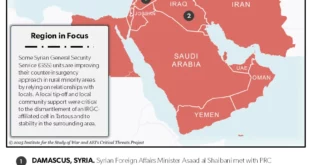The Taliban have enabled some terrorist groups and reined in others, elevating longstanding concerns for U.S. policy.
Two years into Taliban rule, the question of whether Afghanistan would once again become a safe haven for international terrorism remains alive. Longstanding fears were affirmed a little over a year ago, when the U.S. government located al-Qaeda leader Aimen al-Zawahiri in Kabul, Afghanistan, before killing him in a drone strike. The fact that the Taliban would bring Zawahiri back to Kabul, despite repeated assurances to U.S. negotiators both before and after the Doha agreement that they had distanced themselves from al-Qaeda, significantly elevated concerns.
However, the drone strike also allowed the Biden administration to argue that it has a workable counterterrorism strategy to mitigate the remaining threat from Afghanistan. Ever since, policymakers seem to draw comfort from the fact that the Taliban, at the very least, appear to be confronting the Islamic State in Afghanistan — with President Biden even suggesting, in passing, that the Taliban are helping contain terrorist threats from the country.
So, where exactly does the terrorism threat stand on the second anniversary of Taliban rule, and what is the Taliban’s role in incubating and checking various terrorist groups? What explains the Taliban’s choices? And what are the implications of the Taliban’s posture and the threat picture for U.S. counterterrorism policy?
The Threat Picture in Afghanistan
Terrorist groups in Afghanistan fall into two categories: those allied with the Taliban and those opposed to the Taliban. Among the Taliban’s allies are al-Qaeda, the Tehreek-e-Taliban Pakistan (TTP), and a number of Central Asian jihadis. The main group of concern that’s opposed to the Taliban is the Islamic State Khorasan (ISIS-K).
In the first year of Taliban rule, al-Qaeda began to rear its head in Afghanistan. The group started messaging more actively. Its then-leader Zawahiri issued more statements than he had in a long time, with some inciting violence. Zawahiri’s presence in Kabul, Afghanistan, marked the peak of al-Qaeda’s post-takeover activity.
However, since then, al-Qaeda has been relatively subdued, even remaining silent about the killing of its leader as reports surfaced that the group appointed Saif al-Adl to succeed Zawahiri. Last week, in the most significant incitement of violence by the group over the last year, al-Qaeda central leadership issued threats against Sweden and Denmark, calling for the targeting of their embassies across the world. In a recently declassified report, the U.S. intelligence community assessed that al-Qaeda lacks the capability to pose a threat to the United States through 2024.
Compared to al-Qaeda’s central leadership, its South Asia affiliate, AQIS, was more active in messaging and seeking support for jihadist causes, in particular against India. Yet even AQIS hasn’t been complicit in any incidents of violence. There are reports that AQIS, as well as perhaps al-Qaeda central leadership in country, is now being handled by a department responsible for foreign fighters within the Taliban’s intelligence agency, the GDI.
In contrast to al-Qaeda, the TTP — with a presence of thousands of fighters across eastern Afghanistan — vigorously expanded and escalated its operations against Pakistan, killing hundreds of Pakistani security forces personnel and even some civilians. The group appeared to be easily marshalling material resources, from weapons to recruits, from its safe havens in Afghanistan, including some Afghan Taliban fighters.
Among Central Asian jihadis, Tajikistan-focused jihadis that are part of the Jamaat Ansarullah attempted cross-border infiltration and attacks, while the Turkistan Islamic Party also remained in the country.
As for ISIS-K, the group’s overall violence dropped over the last year and it also failed to expand its territorial presence, which was a concern when the Taliban first came to power. The Taliban have been working to neutralize ISIS-K and successfully eliminated some of its leaders this year, potentially including a commander involved in the attack at Hamid Karzai International Airport in Kabul during the evacuation in August 2021.
However, ISIS-K still managed to conduct some high-profile attacks, including killing two Taliban provincial governors, as well as attacks in neighboring Pakistan and Iran. It has also demonstrated signs of integration into a strong transnational network, with reports that the group is receiving funding and guidance from ISIS in Iraq, Syria and Somalia and providing direction to operatives in Maldives. The group appears to regularly transmit funds for plotting activities, with indications of active and foiled plots. While there were reports of disruptions in ISIS-K propaganda, recent releases by the group suggest that its propaganda is back on track.
Taliban Policy Toward International Terrorists
On the face of it, the Taliban insist they are committed to denying the use of their territory by terrorist groups against other countries. However, closer examination reveals that the Taliban’s policy toward militants has three main facets: enablement, restrictions and crackdown.
The Taliban enable various militant groups by providing them continued haven and safety within the country. The Taliban also do not restrict the movement of at least some of these militants inside the country. Moreover, the Taliban provide welfare payments and access to weaponry and ammunition to allied groups, among other forms of material support.
Yet this enablement often comes with certain restrictions. For instance, the Taliban seem to have asked al-Qaeda to not undertake attacks against the United States and its allies, as indicated by both U.S. intelligence assessments and al-Qaeda’s own messaging. Additionally, the Taliban prevent groups within the country from disclosing their locations in their propaganda. This has led to AQIS releasing written materials without accompanying videos. The TTP also denies being based in Afghanistan.
More recently, the Taliban have attempted to discourage their own fighters from joining foreign jihadist groups. The extent to which the Taliban can exert actual control over this complex militant environment remains unclear, but indications suggest that the Taliban have a formal apparatus as part of the GDI to manage foreign fighters within the country.
Against ISIS-K, the Taliban’s crackdown seems to have at least three different verticals: targeting high-value targets such as top ISIS-K leaders; a large-scale counterintelligence campaign within the Taliban’s ranks in search of insiders working for ISIS-K; and punishing segments of populations perceived to be aligned with ISIS-K, such as the Salafi population in the east and north of the country. This campaign seems to be spearheaded by Taliban’s GDI with the involvement of forces from the Ministry of Defense as well.
What explains the terrorism threats and the Taliban’s policy?
Terror groups in Afghanistan appear to remain resolved to long-term campaigns against their respective adversaries. The TTP appears to be moving most aggressively, building up its organization and expanding, whereas others, like al-Qaeda, appear circumspect.
Some, including U.S. intelligence analysis, attribute the cautious approach of al-Qaeda to capacity limitations rooted in organizational weakness. But in Afghanistan’s highly permissive environment, capability buildup for most militants, including al-Qaeda, isn’t a challenge so long as they don’t directly contest the Taliban. A more likely explanation is that Taliban allied terrorist groups are working within the parameters laid down for them by the Taliban. If any group appears to be lower capacity and not rapidly building up organizational strength, most likely that is by choice, perhaps in deference to the Taliban.
When it comes to the Taliban, some analysts suggest that the Taliban have initiated a long and slow process of reining in militants. Others say that the Taliban perhaps lack the capacity to take on some of their allied militants and also fear provoking a backlash. A more plausible explanation is that the Taliban retain their longstanding political desire to be a host to foreign jihadists who are dissidents in their own countries, as well as a supporter of jihadist campaigns internationally — especially in Pakistan. The Taliban chief Hibatullah Akhundzada has spoken about a long, enduring ideological battle in general and with the Western world in particular. He has also spoken negatively about Pakistan’s political system.
At the same time, the Taliban are also attempting to strike a delicate balance between fulfilling their jihadist ambitions as well as obligations to jihadist brethren on one hand and restraining their activities for geopolitical ends on the other. This restraint seems to be intended to avoid jeopardizing their own regime’s survival due to potential actions outside powers can take, including by forging an international consensus and military action against them.
In the same vein, the Taliban’s crackdown against ISIS-K is rooted in self-preservation. The Taliban see ISIS-K as an implacable foe and the main opposition group that’s able to make political and religious appeals with the most direct potential to weaken the Taliban internally. Thus, the Taliban seek to forcefully counter it.
Implications for U.S. Policy
Current terrorism activity traceable to Afghanistan — and the Taliban’s aid and support for terrorists — falls short of the worst-case scenario from a U.S. policy standpoint: There hasn’t been a major attack in the United States; al-Qaeda or ISIS-K haven’t opened largescale training camps in the country; and the Taliban’s words and select deeds, like restraining al-Qaeda from attacks, are an improvement on the Taliban posture the last time they were in power.
As for the terrorist groups that are thriving under the Taliban, like the TTP, policymakers have reason to believe that they are not directly America’s problem — at least until they begin to seriously destabilize Pakistan and threaten the security of its nuclear weapons or demonstrate an intent to target the United States. The Taliban’s continued and forceful targeting of ISIS-K is also a favorable outcome. But despite some behind the scenes exchanges between the United States and the Taliban, it doesn’t appear to be a function of any incentive offered by the United States or the international community. The Taliban’s own threat perception motivates them to go after ISIS-K. And their decision to somewhat restrict al-Qaeda seems to be a result of the threat of U.S. targeting and diplomatic pressure — thereby constituting a case of deterrence.
Yet the distance between the Taliban’s stated position of preventing Afghanistan’s territory from being a threat to other countries and their actual policy of supporting several terrorist groups should be concerning. Whether the benefits accrued by terrorist groups that are not America’s immediate problem will begin to spillover or offer opportunities for terrorist groups that are of concern to the United States, such as al-Qaeda and ISIS-K, is unclear and should be a focus of counterterrorism strategists. It is also not clear that the Taliban’s ongoing campaign against ISIS-K will effectively degrade the group, especially when they are resorting to indiscriminate tactics against the country’s Salafi population.
Washington should communicate to the Taliban through a dedicated intelligence channel — as well as through shows of force when necessary — that in case of any attacks on the United States or core U.S. interests by the Taliban’s allied terrorist groups, the protections they have under the Doha agreement will go away and major consequences will follow. The channel should also be used to convey concerns and explore the possibility of exchanges on shared threats.
The United States should maintain the international coalition of withholding full normalization of ties with the Taliban and other terrorism-related sanctions until there is demonstrable proof that terrorist groups are being denied safe haven in Afghanistan. To reinforce the over-the-horizon posture, the United States should beef up counterterrorism-specific intelligence analysis capabilities consisting of analysts, linguists and screeners available to the military while also expanding the Rewards for Justice program to generate leads. The terror landscape in Afghanistan remains highly uncertain and dynamic, requiring significant vigilance.
 Eurasia Press & News
Eurasia Press & News



